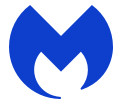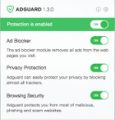What is QuicklookPI
QuicklookPI is a potentially unwanted application (PUA) that falls under the category of Adware. Adware can cause issues for your MAC system. The QuicklookPI adware can display intrusive advertisements on your computer screen so that your cannot block them, redirect your internet browser to misleading web pages, and it can cause scam webpages to pop up on your web-browser. Adware might end up on your MAC system after you download and install free apps from a questionable web page.
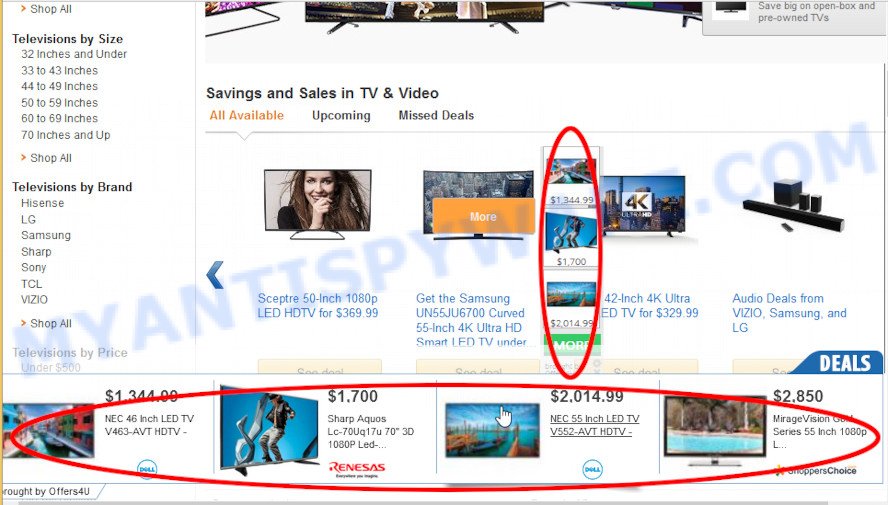
Unwanted ads
Even worse, adware is able to gather your surfing history and personal info, including passwords and credit card numbers. In the future, user data about you can be used for marketing purposes. So, iIf you are unfortunate have adware software or malware running on your Apple Mac, then follow the steps below to remove QuicklookPI from your computer and web browser.
How does QuicklookPI get on your MAC OS
Most of unwanted advertisements and popups come from web browser toolbars and/or add-ons, BHOs (browser helper objects) and additional programs. Most often, these items claim itself as apps that improve your experience on the Web by providing a fast and interactive homepage or a search engine that does not track you. Remember, how to avoid the unwanted programs. Be cautious, launch only reputable programs which download from reputable sources. NEVER install any unknown and questionable applications.
Threat Summary
| Name | QuicklookPI |
| Type | adware software, PUP (potentially unwanted program), Mac virus, Mac malware |
| Detection Names | OSX.Trojan.Gen, Adware/Adload!OSX, MacOS.Agent-MT, Program:MacOS/Vigram.A, Trojan-Downloader.OSX.Adload, Osx.Adware.Cimpli, ApplicUnwnt and Adware.MAC.Generic |
| Distribution | Freeware installers, malicious pop up ads, torrent downloads and fake update tools |
| Symptoms | When you go to a website, you’re frequently redirected to another web-page that you do not intend to visit, advertising pop-ups won’t go away, there is an unwanted application in the ‘Applications’ section of the Finder, new addons suddenly added on your browser, your internet browser homepage has replaced without your permission, low ping but slow Internet. |
| Removal | QuicklookPI removal guide |
How to remove QuicklookPI adware
There exist several free adware removal utilities. Also it is possible to remove QuicklookPI manually. But we suggest to combine all these ways below into the one removal algorithm. Follow the steps of the guide. Read this manual carefully, bookmark it or open this page on your smartphone, because you may need to shut down your web-browser or restart your MAC OS.
To remove QuicklookPI, execute the steps below:
- Remove unwanted profiles on Mac device
- Remove QuicklookPI related programs through the Finder
- Remove QuicklookPI related files and folders
- Scan your Mac with MalwareBytes
- Remove QuicklookPI from Safari, Chrome, Firefox
- How to stay safe online
- Finish words
Remove unwanted profiles on Mac device
QuicklookPI can install a configuration profile on the Mac system to block changes made to the browser settings. Therefore, you need to open system preferences, find and delete the profile installed by the adware software.
Click Apple menu ( ![]() ) > System Preferences.
) > System Preferences.
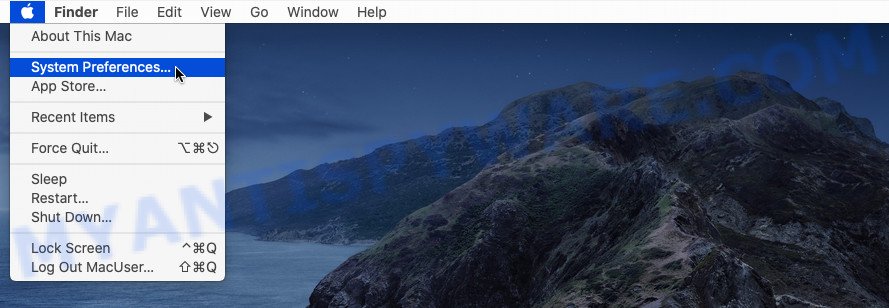
In System Preferences, select Profiles. if there is no Profiles in the list of preferences, that means there are no profiles installed on the Mac computer. If there is Profiles in the list, then click on it, then select a profile associated with QuicklookPI.
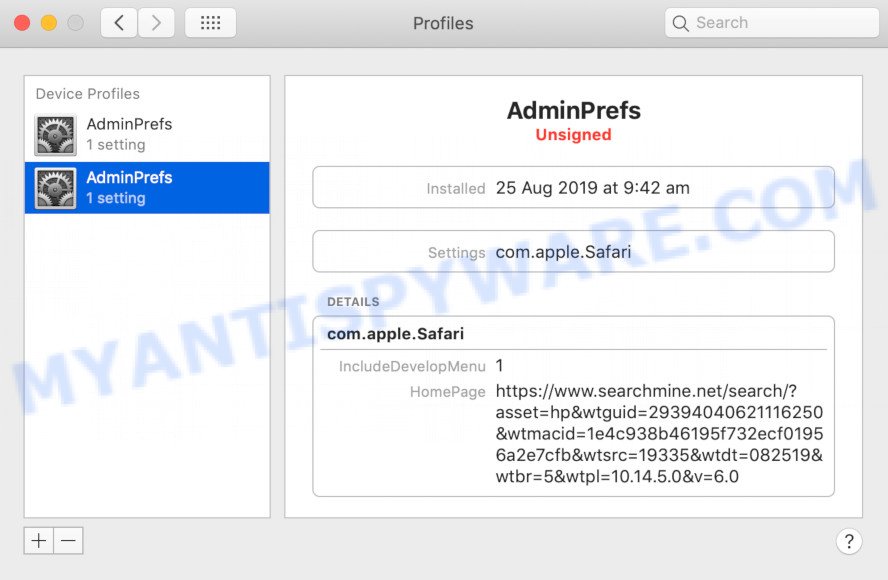
To delete a malicious profile, click on the minus button ( – ) located at the bottom-left of the Profiles screen.
Remove QuicklookPI related programs through the Finder
Check out the Finder (Applications section) to see all installed apps. If you see any unknown and questionable programs, they are the ones you need to delete.
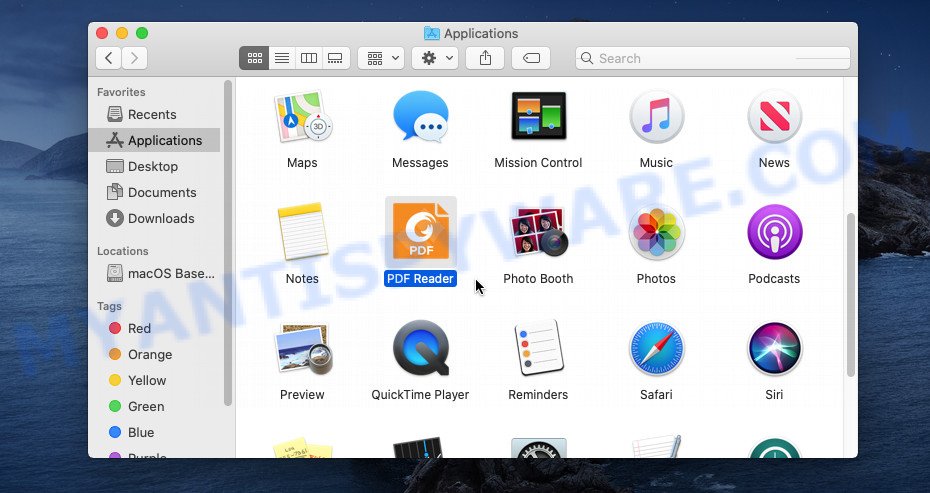
- Open the Finder.
- Click “Applications”.
- It will show a list of all applications installed on the MAC OS.
- Scroll through the all list, and uninstall questionable and unknown software. Pay maximum attention to the program you installed last.
- Drag the questionable program from the Applications folder to the Trash.
- Empty Trash.
Remove QuicklookPI related files and folders
Now you need to try to find QuicklookPI related files and folders, and then delete them manually. You need to look for these files in certain directories. To quickly open them, we recommend using the “Go to Folder…” command.
QuicklookPI creates several files, these files must be found and removed. Below is a list of files associated with this unwanted application.
- /Library/LaunchDaemons/com.QuicklookPI.system.plist
- ~/Library/LaunchAgents/com.QuicklookPI.service.plist
- /Library/Application Support/.(RANDOM)/System/com.QuicklookPI.system
- ~/Library/Application Support/.(RANDOM)/Services/com.QuicklookPI.service.app
Some files created by QuicklookPI are hidden from the user. To find and delete them, you need to enable “show hidden files”. To do this, use the shortcut CMD + SHIFT + . Press once to show hidden files and again to hide them. There is another way. Click Finder -> Applications -> Utilities -> Terminal. In Terminal, paste the following text: defaults write com.apple.finder AppleShowAllFiles YES

Press Enter. Hold the ‘Option/alt’ key, then right click on the Finder icon in the dock and click Relaunch.
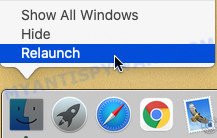
Click on the Finder icon. From the menu bar, select Go and click “Go to Folder…”. As a result, a small window opens that allows you to quickly open a specific directory.

Check for QuicklookPI generated files in the /Library/LaunchAgents folder

In the “Go to Folder…” window, type the following text and press Go:
/Library/LaunchAgents
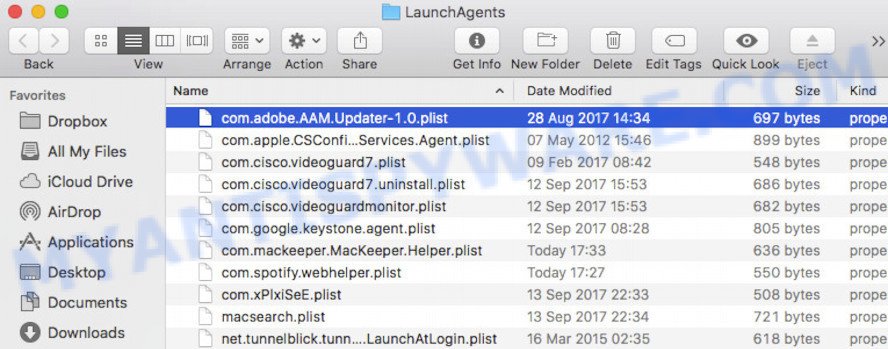
This will open the contents of the “/Library/LaunchAgents” folder. Look carefully at it and pay special attention to recently created files, as well as files that have a suspicious name. Move all suspicious files to the Trash. A few examples of files: com.google.defaultsearch.plist, , installapp.plist, com.net-preferences.plist, com.machelper.plist, com.QuicklookPI.service.plist, search.plist and macsearch.plist. Most often, adware software, PUPs and browser hijackers create several files with similar names.
Check for QuicklookPI generated files in the /Library/Application Support folder

In the “Go to Folder…” window, type the following text and press Go:
/Library/Application Support
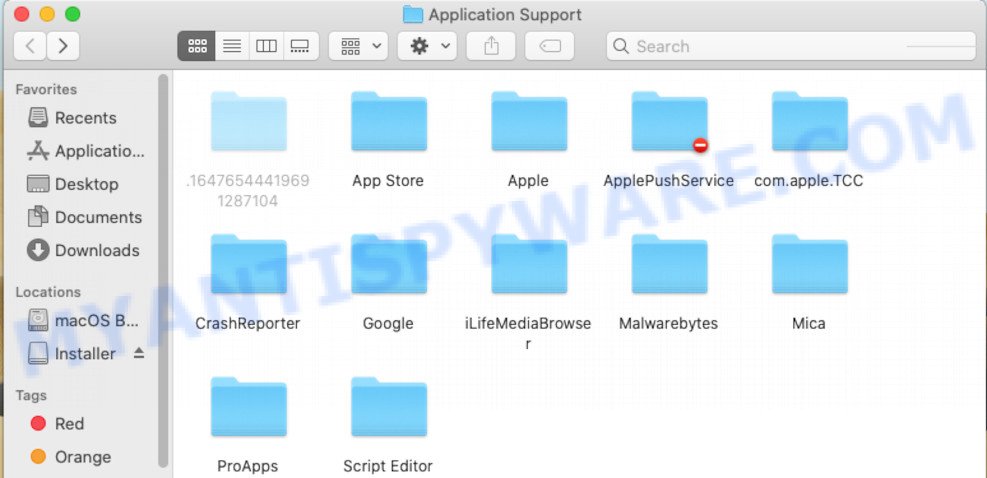
This will open the contents of the “Application Support” folder. Look carefully at its contents, pay special attention to recently added/changed folders and files. Check the contents of suspicious folders, if there is a file with a name similar to com.QuicklookPI.system, then this folder must be deleted. Move all suspicious folders and files to the Trash.
Check for QuicklookPI generated files in the “~/Library/LaunchAgents” folder

In the “Go to Folder…” window, type the following text and press Go:
~/Library/LaunchAgents

Proceed in the same way as with the “/Library/LaunchAgents” and “/Library/Application Support” folders. Look for suspicious and recently added files. Move all suspicious files to the Trash.
Check for QuicklookPI generated files in the /Library/LaunchDaemons folder
In the “Go to Folder…” window, type the following text and press Go:
/Library/LaunchDaemons

Carefully browse the entire list of files and pay special attention to recently created files, as well as files that have a suspicious name. Move all suspicious files to the Trash. A few examples of files to be deleted: com.installapp.system.plist, com.machelper.system.plist, com.search.system.plist, com.QuicklookPI.system.plist and com.macsearch.system.plist. In most cases, adware, browser hijackers and potentially unwanted programs create several files with similar names.
Scan your Mac with MalwareBytes
We suggest using MalwareBytes Anti Malware to scan the Mac computer for potentially unwanted programs, browser hijackers and adware. This free utility is an advanced malware removal program developed by (c) Malwarebytes lab. This program uses the world’s most popular antimalware technology. It is able to help you remove PUPs and other security threats from your Mac for free.
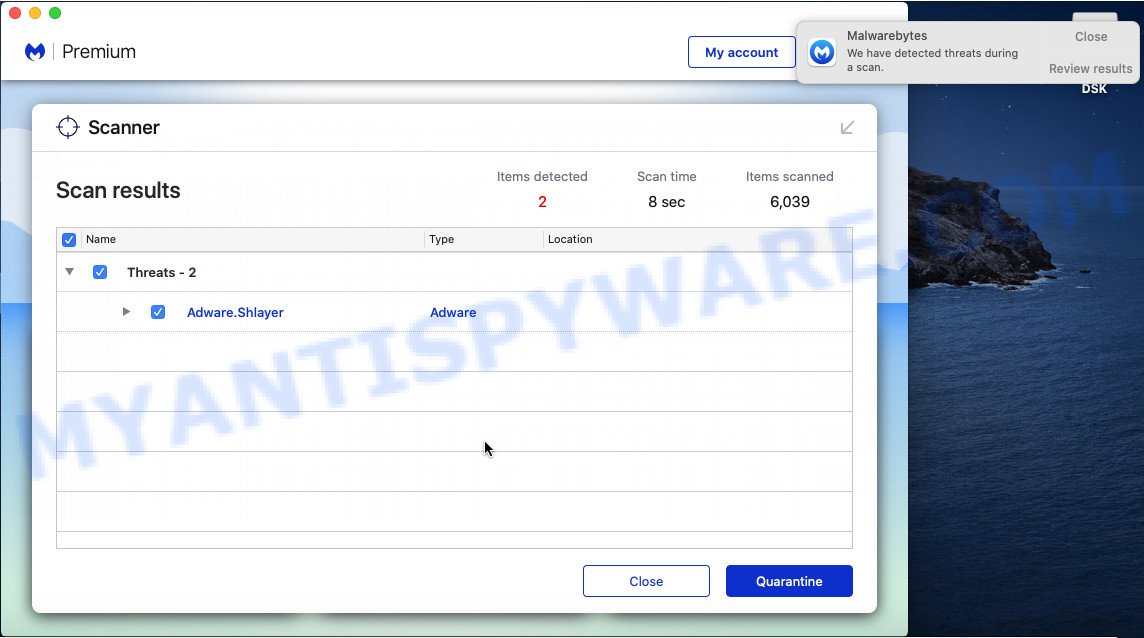
Visit the following page to download the latest version of MalwareBytes Anti-Malware (MBAM) for Mac.
21008 downloads
Author: Malwarebytes
Category: Security tools
Update: September 10, 2020
After the download is complete, run it and follow the prompts. Click the “Scan” button for checking your MAC OS for the QuicklookPI adware. This task can take quite a while, so please be patient. While the MalwareBytes is checking, you can see how many objects it has identified either as being malicious software. Review the report and then press the “Quarantine” button.
The MalwareBytes Anti-Malware (MBAM) is a free application that you can use to get rid of all detected folders, files, malicious services and so on.
Remove QuicklookPI from Safari, Chrome, Firefox
Remove unwanted extensions is a easy method to remove QuicklookPI adware and restore internet browser’s settings that have been changed by adware software.
You can also try to get rid of QuicklookPI adware software by reset Chrome settings. |
If you are still experiencing issues with QuicklookPI adware removal, you need to reset Mozilla Firefox browser. |
|
How to stay safe online
Use an ad-blocker tool like AdGuard will protect you from malicious advertisements and content. Moreover, you may find that the AdGuard have an option to protect your privacy and block phishing and spam web sites. Additionally, ad blocker software will help you to avoid intrusive pop-up advertisements and unverified links that also a good way to stay safe online.
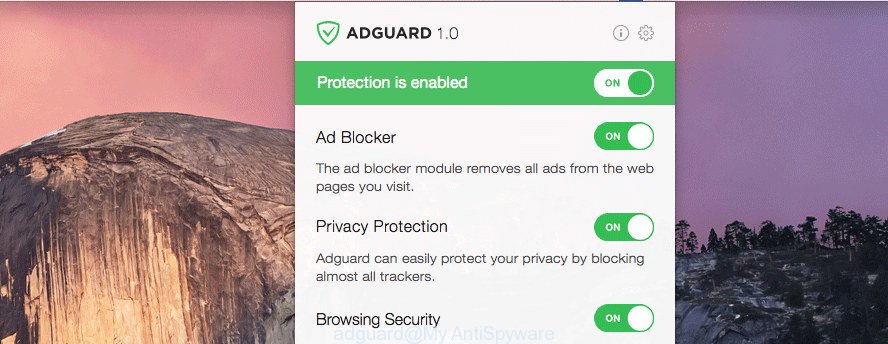
- Click the link below to download AdGuard.
AdGuard for Mac download
3779 downloads
Author: © Adguard
Category: Security tools
Update: January 17, 2018
- Once downloading is done, run the downloaded file. You will see the “Setup Wizard” program window. Follow the prompts.
- When the setup is complete, press “Skip” to close the setup program and use the default settings, or click “Get Started” to see an quick tutorial which will allow you get to know AdGuard better.
- In most cases, the default settings are enough and you do not need to change anything. Each time, when you launch your MAC system, AdGuard will start automatically and stop intrusive advertisements, block harmful and misleading web pages.
Finish words
Now your computer should be clean of the QuicklookPI adware. We suggest that you keep AdGuard (to help you block unwanted ads and annoying malicious web sites) and MalwareBytes AntiMalware (MBAM) (to periodically scan your Apple Mac for new adwares and other malicious software).
If you are still having problems while trying to remove QuicklookPI from the Safari, Firefox and Chrome, then ask for help here here.
